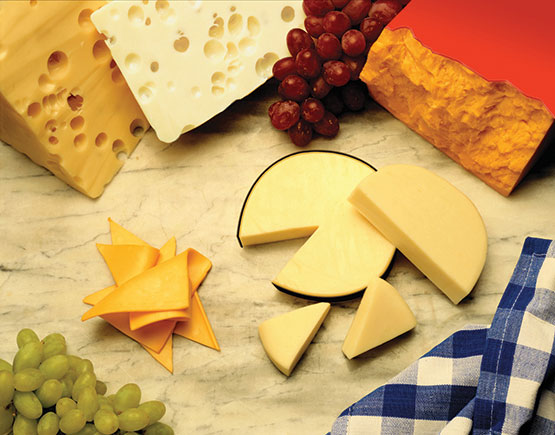Cheese Me
The following is a guide to types of cheeses and common uses for each type:
VERY HARD
Parmesan/Romano
Ten inches or rounds; wedges or grated, yellow-white with brown or black coating. Granular.
Flavor: Sharp/Piquant
Use: Table cheese when cured 5 – 8 months, grated when cured after 1 year.
Grated: on soups, breads, vegetables, spaghetti, in cooked foods.
HARD
Swiss
Rindless blocks and large wheels with rind. Slices, random weights. Light yellow. Firm elastic body with large holes.
Flavor: Nutlike, rather sweet
Use: As such, appetizers, salads, sandwiches, in cooked foods.
Cheddar
Large wheels, cylinders (longhorn shape), blocks, random weights, slices, shredded. Range from white to orange. Smooth, firm body.
Flavor: Mild to sharp
Use: As such, appetizers, salads, sandwiches, in cooked foods, desserts.
Colby
Cylindrical, random weights, slices. Light yellow to orange. Softer and more open in texture than cheddar.
Flavor: Mild Use: As such, sandwiches, in cooked foods.
Provolone
Spherical or sausage shaped. Sliced. Light yellow. Smooth, plastic.
Flavor: Mellow to sharp and piquant. Usually smoked.
Use: As such, appetizers, sandwiches, in cooked foods, with fruit for dessert.
SEMISOFT TO HARD
Edam/Gouda
Red wax outer surface. Like a flattened sphere or loaf shape. Random weights from ¾ to 14 lbs. Baby Gouda weights about 1 lb. Gouda contains slightly more fat. Creamy yellow. Softer than cheddar;more open, mealy body.
Flavor: Mild, nutlike
Use: As such, appetizers, salads, with fruit for dessert.
SEMISOFT
Muenster/Brick
Cylindrical and flat at ends; loaf shaped. Loaf, brick. Both available as random weights, slices. Creamy white. Open texture with numerous round and irregularly shaped eyes.
Flavor: Mild, but rather pungent
Use: As such, appetizers, salads, sandwiches, with fruit for dessert.

Monterey/Monterey Jack
Cylindrical, sliced, random weights. Creamy white. Open texture.
Flavor: Mild
Use: As such, appetizers, sandwiches, in cooked foods, with fruit for dessert.
SOFT
Brie
Small wheels in foil or foil-wrapped wedges. Reddish yellow crust. Yellow creamy interior.
Flavor: Mild to pungent
Use: As such, for desserts with crackers or fruit.
Camembert
Small wheels in foil or foil-wrapped wedges. Rind: thick layer of gray mold with yellow creamy or almost fluid interior.
Flavor: Mild to pungent
Use: As such, for desserts with crackers or fruit.
Nutritional Benefits of Cheese
Cheese is a concentrated source of all the same naturally-occurring nutrients that are found in milk:
- Cheese is an excellent source of calcium, and accounts for 25% of the calcium in the overall food supply
- Calcium helps build strong bones and teeth, and also helps to prevent osteoporosis
Cheese also contains other essential nutrients:
Phosphorus, Zinc, Vitamin A, Riboflavin, Vitamin B12, Protein, Folate, Magnesium
There are dozens of varieties of low-fat cheeses available on the market:
| Low-Fat Cheeses | High-Fat Cheeses |
|---|---|
| Neufchatel | Original cream cheese |
| *Light* cream cheese | |
| Fat-free cream cheese | |
| Reduced-calorie cheese | Regular cheese (Cheddar, Swiss, Jack, American) |
| Low-calorie processed cheeses | |
| Fat-free cheeses (i.e., American Fat-Free) | |
| Low-fat (1%) or reduced-fat (2%) cottage cheese | Regular (4%) cottage-cheese |
| Part-skim milk, low-moisture mozzarella cheese | Whole milk mozzarella cheese |
| Part-skim milk ricotta cheese | Whole milk ricotta cheese |

